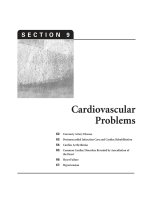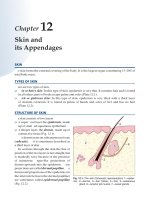Ebook Shafer''s textbook of oral pathology (7th edition): Part 1
Bạn đang xem bản rút gọn của tài liệu. Xem và tải ngay bản đầy đủ của tài liệu tại đây (17.43 MB, 2,081 trang )
Shafer • Hine • Levy
Shafer’s Textbook of Oral
Pathology
Seventh Edition
R Rajendran, MDS, PhD, FRCPath
Professor and Consultant, Division of Oral Pathology,
College of Dentistry, King Saud Bin Abdul Aziz University
for Health Sciences, National Guard Health Affairs (NGHA),
Riyadh, Kingdom of Saudi Arabia
Formerly Professor and Head, Department of Oral Pathology
and Microbiology, Government Dental College, Trivandrum,
INDIA
B Sivapathasundharam, MDS
Professor and Head, Department of Oral Pathology,
Meenakshi Ammal Dental College, Chennai, INDIA
2
Table of Contents
Cover image
Title page
Copyright
Dedication
Foreword
Preface to the Seventh Edition
Preface to the First Edition
Contributors
Acknowledgements
Section I: Disturbances of Development and Growth
Chapter 1: Developmental Disturbances of Oral and Paraoral
Structures
Craniofacial Anomalies
Developmental Disturbances of Jaws
Abnormalities of Dental Arch Relations
3
Developmental Disturbances of Lips And Palate
Hereditary Intestinal Polyposis Syndromen
Developmental Disturbances of Oral Mucosa
Developmental Disturbances of Gingiva
Developmental Disturbances of Tongue
Developmental Disturbances of Oral Lymphoid Tissue
Developmental Disturbances of Salivary Glands
Developmental Disturbances in Size of Teeth
Developmental Disturbances in Shape of Teeth
Developmental Disturbances in Number of Teeth
Developmental Disturbances in Structure of Teeth
Disturbances of Growth (Eruption) of Teeth
Fissural (Inclusion, Developmental) Cysts of Oral Region
Chapter 2: Benign and Malignant Tumors of the Oral Cavity
Benign Tumors of Epithelial Tissue Origin
‘Premalignant’ Lesions/Conditions of Epithelial Tissue
Origin
Malignant Tumors of the Epithelial Tissue Origin
4
Benign Tumors of Connective Tissue Origin
Malignant Tumors of Connective Tissue Origin
Benign Tumors of Muscle Tissue Origin
Malignant Tumors of Muscle Tissue Origin
Benign Tumors of Nerve Tissue Origin
Malignant Tumors of Nerve Tissue Origin
Chapter 3: Tumors of the Salivary Glands
Benign Tumors of the Salivary Glands
Malignant Tumors of the Salivary Glands
Other Carcinomas
Chapter 4: Cysts and Tumors of Odontogenic Origin
Inflammatory Cysts
Tumors of odontogenic origin
Odontogenic epithelium with odontogenic ectomesenchyme
with or without hard tissue formation
Odontogenic ectomesenchyme with or without included
odontogenic epithelium
Malignant odontogenic tumors
5
Odontogenic Carcinomas
Section II: Diseases of Microbial Origin
Chapter 5: Bacterial Infections of the Oral Cavity
Chapter 6: Viral Infections of the Oral Cavity
Oral Manifestations of Hiv Infection
Human Immunodeficiency Virus
Chapter 7: Mycotic Infections of the Oral Cavity
Chapter 8: Diseases of the Periodontium
The Healthy Periodontium
Classification of Periodontal Disease
Gingival Diseases
Enlargement Associated with Systemic Factors
Periodontitis
Peri-Implantitis
Chapter 9: Dental Caries
Etiology of Dental Ca ries
Clinical Aspects of Dental Caries
6
Histopathology of Dental Caries
Diagnosis of Dental Caries
Methods of Caries Control
Chapter 10: Diseases of the Pulp and Periapical Tissues
Diseases of Dental Pulp
Classification of Pulpitis
Diseases of Periapical Tissues
Osteomyelitis
Chapter 11: Spread of Oral Infection
Infections of Specific Tissue Spaces
Ludwig’s Angina
Maxillary Sinusitis
Focal Infection
Section III: Injuries and Repair
Chapter 12: Physical and Chemical Injuries of the Oral Cavity
Injuries of Teeth Associated with Tooth Preparation
Effect of Heat
7
Effect of Restorative Materials
Physical Injuries of the Teeth
Physical Injuries of the Bone
Occupational Injuries of the Oral Cavity
Occlusal Trauma
Chapter 13: Regressive Alterations of the Teeth
Attrition, Abrasion and Erosion
Abfraction
Dentinal Sclerosis: (Transparent Dentin)
Dead Tracts
Secondary Dentin
Reticular Atrophy of Pulp
Pulp Calcification
Resorption of Teeth
Hypercementosis: (Cementum Hyperplasia)
Cementicles
Chapter 14: Healing of Oral Wounds
8
Factors Affecting Healing of Oral Wounds
Complications of Wound Healing
Biopsy and Healing of Biopsy Wound
Exfoliative Cytology
Healing of Extraction Wound
Complications in Healing of Extraction Wounds
Healing of Fracture
Complications of Fracture Healing
Replantation and Transplantation of Teeth
Implants
Section IV: Disturbances
Immunologic Diseases
of
the
Metabolism
Chapter 15: Oral Aspects of Metabolic Diseases
Disturbances in Mineral Metabolism
Disturbances in Protein Metabolism
Individual Amino Acids
Lysosomal Storage Diseases
Disturbances in Carbohydrate Metabolism
9
and
Hurler Syndrome: (Mucopolysaccharidosis I, MPS IH,
gargoylism)
Disturbances in Lipid Metabolism
Avitaminoses
Disturbances in Hormone Metabolism
Chapter 16: Allergic and Immunologic Diseases of the Oral
Cavity
Recurrent Aphthous Stomatitis: (Aphthous ulcers, aphthae,
canker sores)
Behçet’s Syndrome
Reiter’s Syndrome
Sarcoidosis: (Boeck’s sarcoid, Besnier-Boeck-Schaumann
disease)
Uveoparotid Fever: (Uveoparotitis, Heerfordt’s syndrome)
Midline Lethal Granuloma: (Malignant granuloma, lethal
granuloma, midline lethal granulomatous ulceration)
Wegener’s Granulomatosis
Chronic Granulomatous Disease
Angioedema: (Angioneurotic edema, Quincke’s edema, giant
urticaria)
10
Drug Allergy: (Drug idiosyncrasy, drug sensitivity, stomatitis
or dermatitis medicamentosa)
Contact Stomatitis and Dermatitis: (Stomatitis and dermatitis
venenata)
Contact Stomatitis from Cinnamon Flavoring
Contact Stomatitis from Chronic Oral Mucosal Contact with
Dental Amalgam
Lichenoid Reaction: (Lichenoid mucositis, lichenoid drug
reaction, lichenoid lesions)
Perioral Dermatitis
Latex Allergy
Section V: Diseases of Specific Systems
Chapter 17: Diseases of Bone and Joints
Group I: Defects in Extracellular Structural Proteins (Based
on Molecular Pathogenetic Classification of Genetic
Disorders of Skeleton)
Diseases of Bone of Questionable Etiology
Diseases of Temporomandibular Joint
Chapter 18: Diseases of the Blood and Blood-forming Organs
Diseases Involving Red Blood Cells
11
Diseases Involving White Blood Cells
Leukocytosis
Diseases Involving Blood Platelets
Thrombocytasthenia
Diseases Involving Specific Blood Factors
Chapter 19: Diseases of the Skin
Pemphigus
Bullous Pemphigoid (Parapemphigus)
Epidermolysis Bullosa
Dermatitis Herpetiformis (Duhring-Brocq disease)
Acrodermatitis Enteropathica: (Zinc deficiency)
Systemic Lupus Erythematosus
Systemic
Sclerosis:
hidebound disease)
(Scleroderma,
dermatosclerosis,
Ehlers-Danlos Syndrome: (Tenascin-X deficiency syndrome,
lysyl hydroxylase deficiency syndrome, cutis hyperelastica)
Focal Dermal Hypoplasia Syndrome: (Goltz's syndrome)
Solar Elastosis: (Senile elastosis, actinic elastosis)
12
Chapter 20: Diseases of the Nerves and Muscles
Diseases of the Nerves
Diseases of the Muscles
Heterotopic Ossification
Section VI: Forensic Odontology
Chapter 21: Forensic Odontology
Personal Identification
Dental Identification Procedures
Identification in Disasters
Identification from Dental Dna
Palatal Rugae in Identification
Dental Profiling
The Dentist as an Expert Witness
Acknowledgements
Appendix I: Introduction to Laboratory Analyses in Oral and
Maxillofacial Pathology
Appendix II: Mucosal Response to Oral Prostheses: Some
Pathological Considerations
13
Appendix III: Routine Histotechniques Staining and Notes on
Immunohistochemistry
Appendix IV: Tables of Normal Values
Index
14
Copyright
Shafer’s Textbook of Oral Pathology, 7/e
Rajendran and Sivapathasundharam
ELSEVIER
A division of Reed Elsevier India Private Limited
Mosby, Saunders, Churchill Livingstone, Butterworth
Heinemann and Hanley & Belfus are the Health Science
imprints of Elsevier.
© 2012 Elsevier
Fourth Edition 1983 © Saunders
Fifth Edition 2006 © Elsevier
Sixth Edition 2009 © Elsevier
Seventh Edition 2012 © Elsevier
All rights reserved. No part of this publication may be
reproduced or transmitted in any form or by any
means—electronic or mechanical, including photocopy,
recording, or any information storage and retrieval
system—without permission in writing from the publisher.
15
This adaptation of Textbook of Oral Pathology, 4/e by
William G. Shafer, Maynard K. Hine and Barnet M. Levy is
published by an arrangement with Elsevier Inc.
Original ISBN: 978-07-216-8128-3
Indian Adaptation ISBN: 978-81-312-3097-8
Notice
Knowledge and best practice in this field are constantly
changing. As new research and experience broaden our
knowledge, changes in practice, treatment and drug therapy
may become necessary or appropriate. Readers are advised to
check the most current information provided (i) on procedures
featured or (ii) by the manufacturer of each product to be
administered, to verify the recommended dose or formula, the
method and the duration of administration, and the
contraindications. It is the responsibility of the practitioners,
relying on their own experience and knowledge of the patient,
and to take diagnoses, to determine dosages and the best
treatment for each individual patient, and to take all
appropriate safety precautions. To the fullest extent of the
law, neither the Publisher nor the Authors assume any
liability for any injury and/or damage to persons or property
arising out or related to any use of the material contained in
this book. Please consult full prescribing information before
issuing prescription for any product mentioned in this
publication.
The Publisher
16
Published by Elsevier, a division of Reed Elsevier India
Private Limited
Registered Office: 305, Rohit House, 3 Tolstoy Marg, New
Delhi-110 001
Corporate Office: 14th Floor, Building No. 10B, DLF Cyber
City, Phase II, Gurgaon-122 002, Haryana, India
Publishing Manager: Ritu Sharma
Commissioning Editor: Nimisha Goswami
Managing Editor (Development): Anand K Jha
Copy Editor: Isha Bali
Manager-Publishing Operations: Sunil Kumar
Production Manager: NC Pant
Cover Designer: Raman Kumar
Typeset by Chitra Computers, New Delhi
Printed and bound at Thomson Press (India) Ltd.
17
Dedication
Dedicated
to
Prof Mansour Faris Hussein, PhD, FRCPath Department of
Pathology College of Food Sciences and Agriculture King
Saud University, Riyadh, Saudi Arabia For being a source of
inspiration to me during this arduous journey
R Rajendran
my wife Dr S Rohini
B Sivapathasundharam
18
Foreword
It is a distinct honor and privilege to have been asked to write
the foreword for this edition of Shafer's Textbook of Oral
Pathology. Dr Shafer, through the text that he co-authored
with Drs Maynard Hine and Barnet Levy, made a tremendous
impact on the practice of dentistry from the first edition,
published in 1958, to the last edition, published in 1983. It is
likely that no other text has ever had such a widespread
influence on the perception of a specialty of dentistry,
essentially establishing that the clinical and histopathologic
diagnosis of oral disease belonged to the practice of dentistry,
and the practice of oral and maxillofacial pathology
specifically.
I was fortunate to have been one of more than 60 individuals
who were trained under ‘the Chief’, as he was widely known
by the people who passed through his department. Understand
that he was a stern taskmaster, and he was serious about the
practice of oral pathology. When a resident made a diagnosis,
Dr Shafer expected that resident to know everything about
that disease, and we spent hours in the library (this was in the
days before computers!) tracking down who first reported that
specific disease, in what year, and in what journal, as well as
the most recent references related to the disease. He never
allowed any of his residents to use his text as a reference,
either. Perhaps he imparted the most significant concept,
consciously or unconsciously, to us: knowledge and
understanding of disease is an ever-changing, evolving
process, and the practitioner must continually keep up with
19
the dental and medical literature in order to remain current
and provide the most accurate, up-to-date patient care.
This textbook, then, provides the dental clinician with some
of the most current viewpoints related to the vast spectrum of
disease that is encountered in the oral and maxillofacial
region. The editors are to be commended on continuing Dr
Shafer’s legacy to the dental and oral pathology communities.
By updating and amplifying the textbook, the authors will
ensure that this knowledge will be handed down to future
generations of practitioners. Future editions will include the
inevitable advances in our understanding of disease processes,
and hopefully will provide the stimulus for new investigators
wishing to advance the science of oral and maxillofacial
pathology. Undoubtedly, this textbook will maintain the
tradition of excellence in oral pathology education that was
established by Dr Shafer and will serve as a valuable resource
for students, instructors and clinicians alike.
Carl M. Allen, DDS, MSD
Professor and Director, Oral and Maxillofacial Pathology,
College of Dentistry, The Ohio State University, Columbus,
Ohio
Professor, Department of Pathology, College of Medicine and
Public Health, The Ohio State University, Columbus, Ohio
20
Preface
Edition
to
the
Seventh
The periodic and timely revisions of Shafer’s Textbook of
Oral Pathology have brought out a treatise, well conceived
and written with the aim of updating the student all necessary
nuances of the specialty. The scope of the present edition is
an extension of this goal aimed at understanding the disease
processes at a more fundamental level, the impetus being
those in the maxillofacial region. While the subject appears
more of loco-regional nature, as the text unfolds, its wider
ramifications become more apparent and the disease entities
described here appear wider in scope and nature. As in the
past, this edition has also undergone an extensive revision and
new topics have been included. A well thought out decision
of incorporating ‘cutting edge’ technologies of relevance such
as molecular markers and disease profiling, continues to be
incorporated in the text with the aim of updating the subject
and making it more contemporary. Scattered throughout the
text one finds highlighted ‘boxes’ which stand out, yet merge
imperceptibly with the rest, denoting advanced information
perhaps beyond the ambit of the undergraduate curriculum. In
this way, the text has been user friendly, though
discriminatory of the scope and choice of its contents. We
believe this approach is sensible and will be well taken by the
readership. This textbook represents a treasury of information
based for the most part, on the publications of our
contemporaries and predecessors. In order to present the
material in an informal manner, continuous referencing to
21
these sources have been discarded. However, the reader will
find a list of suggested references of wider scope at the end of
each chapter.
This edition is peculiar in having new pieces of four-color art
schematics, flowcharts and diagrams primarily aimed at
comprehension of its contents and to facilitate reasoning of
concepts such as the molecular basis of cancer. A change
which is far reaching and marked is the hard copy format of
the text which intends to minimize structural fatigue and
maximize ease of usage. Finally, as was true of the fifth and
sixth editions, all of our associations with the publisher,
Elsevier India were pleasant and helpful. We want to thank
the editorial staff of Elsevier India for their skilled and
friendly assistance in helping us publish this project to
completion successfully.
Deficiencies and shortcomings are rather inevitable in an
effort of this magnitude and for which we shall be solely
responsible. This textbook is dedicated to our contemporaries
and predecessors who have made this effort a reality.
R. Rajendran and
B. Sivapathasundharam
22
Preface to the First Edition
ORAL PATHOLOGY represents the confluence of the basic
sciences and clinical dentistry. Since it has no methods of its
own, knowledge in this field is acquired through the
adaptation of methods and disciplines of those sciences basic
to dental practice, such as gross and microscopic anatomy,
chemistry, microbiology and physiology, and through
information obtained by clinical histories and observation of
patients. Through the science of oral pathology, an attempt is
made to correlate human biology with the signs and
symptoms of human disease. The oral pathologist attempts to
understand oral disease so that it can be properly diagnosed
and adequately treated.
In this text we have attempted to bring the reader to an
understanding of the patient and his problems through applied
basic science. We have tried to explain clinical signs and
symptoms in the light of known histologic, chemical and
physiologic alterations. Where possible, the prognosis of each
disease is considered as a reflection of the underlying tissue
changes and what we know can be done about them today.
In numerous sections of the text we have attempted to
integrate information from many of the basic sciences for
adequate diagnosis of oral disease. This approach is a
departure from that of the usual textbook of oral pathology,
representing an effort to place more emphasis on the
physiologic and chemical aspects of oral disease.
23
The references at the end of each chapter are extensive
enough to be of value to those interested in additional
reading. Only those papers which constitute good review
articles or exceptional discussions or which are of historical
importance are included. Because the field of oral pathology
is large, much of the bibliographic material has had to be
curtailed or omitted. The highlights alone have been stressed.
It is our hope that this book will prove to be a stimulus to
study as well as a guide for undergraduate and postgraduate
students and practitioners of both dentistry and medicine.
The Authors
24
Contributors
Ashith B. Acharya, Assistant Professor,
Department of Forensic Odontology, SDM Dental College,
Dharward
N. Gururaj, Reader,
Department of Oral Pathology, CSI Dental College, Madurai
Mahesh Verma, Director and Dean,
Maulana Azad Institute of Dental Sciences, New Delhi
Praveen R. Arany,
National Cancer Institute National Institutes of Health,
Bethesda, Maryland, USA
A.R. Raghu, Professor and Head,
Department of Oral Pathology, Manipal College of Dental
Sciences, Manipal
K. Ranganathan, Professor and Head,
Department of Oral Pathology, Ragas Dental College,
Chennai
Anil Sukumaran, Professor and Consultant,
Division of Periodontics, College of Dentistry, King Saud
University, Riyadh, Saudi Arabia
Nasser Nooh, Associate Professor and Chairman,
Division of Maxillofacial Surgery, College of Dentistry, King
Saud University, Riyadh, Saudi Arabia
25









